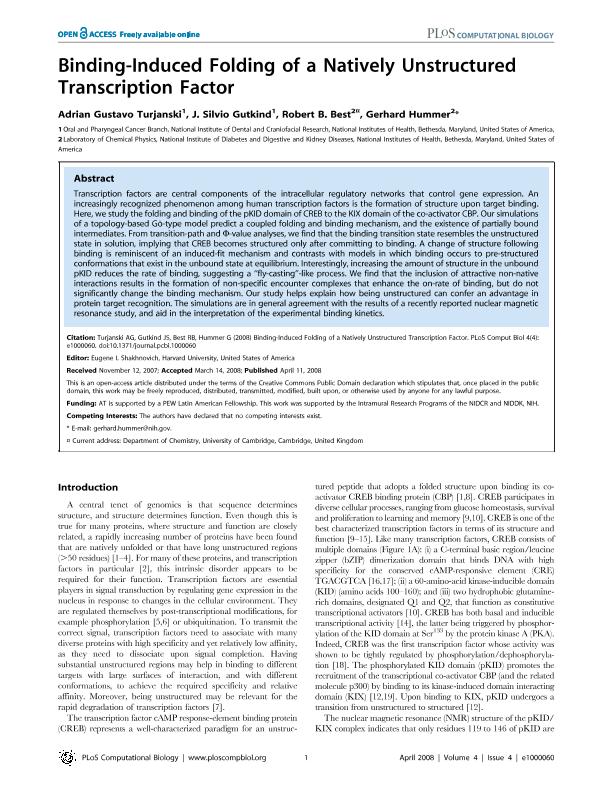Mostrar el registro sencillo del ítem
dc.contributor.author
Turjanski, Adrian

dc.contributor.author
Gutkind, J. Silvio

dc.contributor.author
Best, Robert B.
dc.contributor.author
Hummer, Gerhard
dc.date.available
2020-04-15T14:39:50Z
dc.date.issued
2008-04
dc.identifier.citation
Turjanski, Adrian; Gutkind, J. Silvio; Best, Robert B.; Hummer, Gerhard; Binding-Induced Folding of a Natively Unstructured Transcription Factor; Harvard University; Plos Computational Biology; 4; 4; 4-2008; 1000060-1000070
dc.identifier.issn
1553-7358
dc.identifier.uri
http://hdl.handle.net/11336/102610
dc.description.abstract
Transcription factors are central components of the intracellular regulatory networks that control gene expression. An increasingly recognized phenomenon among human transcription factors is the formation of structure upon target binding. Here, we study the folding and binding of the pKID domain of CREB to the KIX domain of the co-activator CBP. Our simulations of a topology-based Go¯-type model predict a coupled folding and binding mechanism, and the existence of partially bound intermediates. From transition-path and W-value analyses, we find that the binding transition state resembles the unstructured state in solution, implying that CREB becomes structured only after committing to binding. A change of structure following binding is reminiscent of an induced-fit mechanism and contrasts with models in which binding occurs to pre-structured conformations that exist in the unbound state at equilibrium. Interestingly, increasing the amount of structure in the unbound pKID reduces the rate of binding, suggesting a ‘‘fly-casting’’-like process. We find that the inclusion of attractive non-native interactions results in the formation of non-specific encounter complexes that enhance the on-rate of binding, but do not significantly change the binding mechanism. Our study helps explain how being unstructured can confer an advantage in protein target recognition. The simulations are in general agreement with the results of a recently reported nuclear magnetic resonance study, and aid in the interpretation of the experimental binding kinetics.
dc.format
application/pdf
dc.language.iso
eng
dc.publisher
Harvard University
dc.rights
info:eu-repo/semantics/openAccess
dc.rights.uri
https://creativecommons.org/licenses/by/2.5/ar/
dc.subject.classification
Físico-Química, Ciencia de los Polímeros, Electroquímica

dc.subject.classification
Ciencias Químicas

dc.subject.classification
CIENCIAS NATURALES Y EXACTAS

dc.title
Binding-Induced Folding of a Natively Unstructured Transcription Factor
dc.type
info:eu-repo/semantics/article
dc.type
info:ar-repo/semantics/artículo
dc.type
info:eu-repo/semantics/publishedVersion
dc.date.updated
2020-04-14T13:32:19Z
dc.journal.volume
4
dc.journal.number
4
dc.journal.pagination
1000060-1000070
dc.journal.pais
Estados Unidos

dc.journal.ciudad
San Francisco
dc.description.fil
Fil: Turjanski, Adrian. National Institutes of Health; Estados Unidos. National Institute of Dental and Craniofacial Research; Estados Unidos. Consejo Nacional de Investigaciones Científicas y Técnicas; Argentina
dc.description.fil
Fil: Gutkind, J. Silvio. National Institute of Dental and Craniofacial Research; Estados Unidos. National Institutes of Health; Estados Unidos
dc.description.fil
Fil: Best, Robert B.. National Institute of Diabetes and Digestive and Kidney Diseases; Estados Unidos. National Institutes of Health; Estados Unidos
dc.description.fil
Fil: Hummer, Gerhard. National Institutes of Health; Estados Unidos. National Institute of Diabetes and Digestive and Kidney Diseases; Estados Unidos
dc.journal.title
Plos Computational Biology

dc.relation.alternativeid
info:eu-repo/semantics/altIdentifier/url/http://www.ploscompbiol.org/article/info%3Adoi%2F10.1371%2Fjournal.pcbi.1000060
dc.relation.alternativeid
info:eu-repo/semantics/altIdentifier/doi/https://doi.org/10.1371/journal.pcbi.1000060
Archivos asociados
